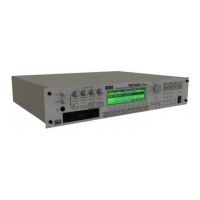86
U200 (E–A) – U327 (E–H)
With the factory settings, these do not contain pat-
terns.
If certain separately sold EXB-PCM series option
boards are installed and the included disk is loaded,
other arpeggio patterns will be added.
4 Make settings for the various parameters.
“Octave”: Select the octave range in which the
arpeggio will be played.
If a user arpeggio pattern is selected, the “Octave
Motion” setting (GLOBAL 6.1: Arp.Pattern, Setup
page) will affect the way in which the arpeggio is
played.
“Reso”: Specifies the spacing of the arpeggio notes
over a range of 3 – .
“Gate”: Specifies the length (gate time) of each note in
the arpeggio. If a user arpeggio pattern is selected, you
can set this to Step. In this case, the value of the “Gt”
setting for each step (GLOBAL 6.1: Arp.Pattern, Edit
page) will be used.
This value will be in effect when the REALTIME
CONTROLS C-mode [ARP-GATE] knob is in the
center position (12 o’clock). Be sure that the knob is
in the center position when you make this setting.
“Velocity”: Specifies the velocity of the notes in the
arpeggio. If this is set to Key, the velocity with which
you actually played the note on the connected MIDI
instrument will be used. If a user arpeggio pattern is
selected, you can set this to Step. In this case, the value
of the “Vel” setting for each step (GLOBAL 6.1:
Arp.Pattern, Edit page) will be used.
This value will be in effect when the REALTIME
CONTROLS C-mode [ARP-VELOCITY] knob is in
the center position (12 o’clock). Be sure that the
knob is in the center position when you make this
setting.
When a preload user arpeggio pattern is selected,
setting the “Gate” or “Velocity” to Step will add a
sense of groove to the arpeggio pattern.
“Swing”: This adjusts the timing of the even-num-
bered notes in the arpeggio (counting from the first
note), to give the pattern a sense of “swing.”
“Sort”: If this is checked, the arpeggio will be
sounded in order of pitch, regardless of the order in
which notes were played on the connected MIDI
instrument (On).
If this is unchecked, the arpeggio will be sounded in
the order in which the notes were played on the con-
nected MIDI instrument (Off).
“Latch”: If this is checked, the arpeggio will con-
tinue playing even after you take your hand off the
keyboard of the connected MIDI instrument. If this
is unchecked, the arpeggio will stop playing when
you take your hand off the keyboard of the con-
nected MIDI instrument.
“Key Sync.”: If this is checked, the arpeggio pattern
will start from the beginning when you play a note
after having released all notes. This setting is suit-
able when you are playing in realtime, and want the
arpeggio to start at the beginning of the measure.
If this is unchecked, the arpeggio pattern will
always be synchronized to the tempo of the MIDI
clock. For details on synchronization, refer to
“About arpeggiator synchronization” (☞p.93).
“Keyboard”: If this is checked, the notes you play
on the keyboard will be heard as well as the arpeggi-
ated notes.
If this is unchecked, only the arpeggiated notes will
be heard.
The same setting can be made by editing the param-
eter of the same name (or abbreviation) in the PROG
1.1: Play, Arp.Play page.
You can use the Utility “Copy Arpeggiator” to
copy arpeggiator settings from another program or
combination (
☞PG p.25).
5 In the Scan Zone page, specify the range in which
the arpeggiator will operate.
“Key Btm,” “Key Top”: The arpeggiator will oper-
ate when you play keys within the specified range.
Keys outside of this range can be played in the nor-
mal manner, and will not be affected by the arpeg-
giator on/off.
For example if you set “Pattern” to P000: UP, check
“Latch,” set “Key Top” to B3, and “Key Btm” to C-
1, playing a note B3 or lower will trigger the arpeg-
giator. Since “Latch” is on, the arpeggio will con-
tinue even after you release the keys. You can use
the C4 and higher keys to play conventionally
along with the arpeggio sounded by the B3 and
lower keys. To change the arpeggio, play keys in
the range of B3 and below.
Octave: 4
UP
ON, UP
Sort
OFF, UP
Sort
① ③ ② ④

